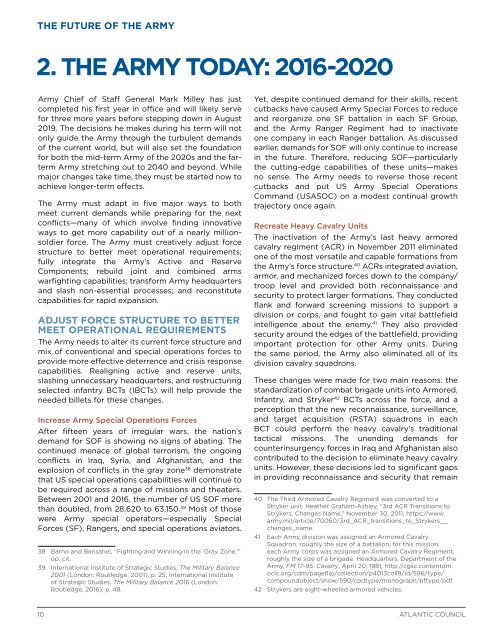FUTURE ARMY
Future_of_the_Army_web_0921
Future_of_the_Army_web_0921
You also want an ePaper? Increase the reach of your titles
YUMPU automatically turns print PDFs into web optimized ePapers that Google loves.
THE <strong>FUTURE</strong> OF THE <strong>ARMY</strong><br />
2. THE <strong>ARMY</strong> TODAY: 2016-2020<br />
Army Chief of Staff General Mark Milley has just<br />
completed his first year in office and will likely serve<br />
for three more years before stepping down in August<br />
2019. The decisions he makes during his term will not<br />
only guide the Army through the turbulent demands<br />
of the current world, but will also set the foundation<br />
for both the mid-term Army of the 2020s and the farterm<br />
Army stretching out to 2040 and beyond. While<br />
major changes take time, they must be started now to<br />
achieve longer-term effects.<br />
The Army must adapt in five major ways to both<br />
meet current demands while preparing for the next<br />
conflicts—many of which involve finding innovative<br />
ways to get more capability out of a nearly millionsoldier<br />
force. The Army must creatively adjust force<br />
structure to better meet operational requirements;<br />
fully integrate the Army’s Active and Reserve<br />
Components; rebuild joint and combined arms<br />
warfighting capabilities; transform Army headquarters<br />
and slash non-essential processes; and reconstitute<br />
capabilities for rapid expansion.<br />
ADJUST FORCE STRUCTURE TO BETTER<br />
MEET OPERATIONAL REQUIREMENTS<br />
The Army needs to alter its current force structure and<br />
mix of conventional and special operations forces to<br />
provide more effective deterrence and crisis response<br />
capabilities. Realigning active and reserve units,<br />
slashing unnecessary headquarters, and restructuring<br />
selected infantry BCTs (IBCTs) will help provide the<br />
needed billets for these changes.<br />
Increase Army Special Operations Forces<br />
After fifteen years of irregular wars, the nation’s<br />
demand for SOF is showing no signs of abating. The<br />
continued menace of global terrorism, the ongoing<br />
conflicts in Iraq, Syria, and Afghanistan, and the<br />
explosion of conflicts in the gray zone 38 demonstrate<br />
that US special operations capabilities will continue to<br />
be required across a range of missions and theaters.<br />
Between 2001 and 2016, the number of US SOF more<br />
than doubled, from 28,620 to 63,150. 39 Most of those<br />
were Army special operators—especially Special<br />
Forces (SF), Rangers, and special operations aviators.<br />
38 Barno and Bensahel, “Fighting and Winning in the ‘Gray Zone,’”<br />
op. cit.<br />
39 International Institute of Strategic Studies, The Military Balance<br />
2001 (London: Routledge, 2001), p. 25; International Institute<br />
of Strategic Studies, The Military Balance 2016 (London:<br />
Routledge, 2016), p. 48.<br />
Yet, despite continued demand for their skills, recent<br />
cutbacks have caused Army Special Forces to reduce<br />
and reorganize one SF battalion in each SF Group,<br />
and the Army Ranger Regiment had to inactivate<br />
one company in each Ranger battalion. As discussed<br />
earlier, demands for SOF will only continue to increase<br />
in the future. Therefore, reducing SOF—particularly<br />
the cutting-edge capabilities of these units—makes<br />
no sense. The Army needs to reverse those recent<br />
cutbacks and put US Army Special Operations<br />
Command (USASOC) on a modest continual growth<br />
trajectory once again.<br />
Recreate Heavy Cavalry Units<br />
The inactivation of the Army’s last heavy armored<br />
cavalry regiment (ACR) in November 2011 eliminated<br />
one of the most versatile and capable formations from<br />
the Army’s force structure. 40 ACRs integrated aviation,<br />
armor, and mechanized forces down to the company/<br />
troop level and provided both reconnaissance and<br />
security to protect larger formations. They conducted<br />
flank and forward screening missions to support a<br />
division or corps, and fought to gain vital battlefield<br />
intelligence about the enemy. 41 They also provided<br />
security around the edges of the battlefield, providing<br />
important protection for other Army units. During<br />
the same period, the Army also eliminated all of its<br />
division cavalry squadrons.<br />
These changes were made for two main reasons: the<br />
standardization of combat brigade units into Armored,<br />
Infantry, and Stryker 42 BCTs across the force, and a<br />
perception that the new reconnaissance, surveillance,<br />
and target acquisition (RSTA) squadrons in each<br />
BCT could perform the heavy cavalry’s traditional<br />
tactical missions. The unending demands for<br />
counterinsurgency forces in Iraq and Afghanistan also<br />
contributed to the decision to eliminate heavy cavalry<br />
units. However, these decisions led to significant gaps<br />
in providing reconnaissance and security that remain<br />
40 The Third Armored Cavalry Regiment was converted to a<br />
Stryker unit. Heather Graham-Ashley, “3rd ACR Transitions to<br />
Strykers, Changes Name,” November 30, 2011, https://www.<br />
army.mil/article/70060/3rd_ACR_transitions_to_Strykers__<br />
changes_name.<br />
41 Each Army division was assigned an Armored Cavalry<br />
Squadron, roughly the size of a battalion, for this mission;<br />
each Army corps was assigned an Armored Cavalry Regiment,<br />
roughly the size of a brigade. Headquarters, Department of the<br />
Army, FM 17-95: Cavalry, April 20, 1981, http://cgsc.contentdm.<br />
oclc.org/cdm/pageflip/collection/p4013coll9/id/596/type/<br />
compoundobject/show/590/cpdtype/monograph/pftype/pdf.<br />
42 Strykers are eight-wheeled armored vehicles.<br />
10 ATLANTIC COUNCIL


